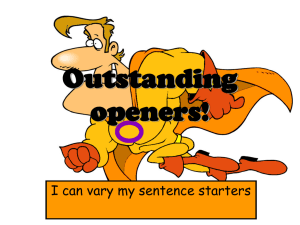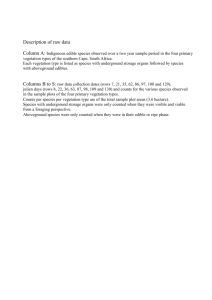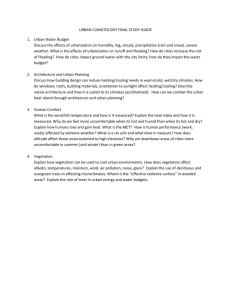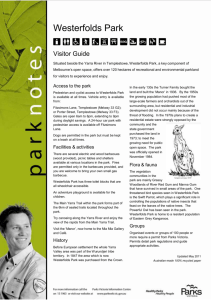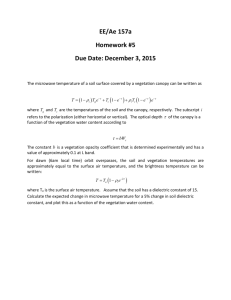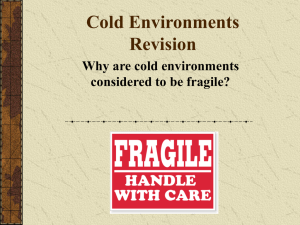Schedule 1 to the Environmental Significance
advertisement
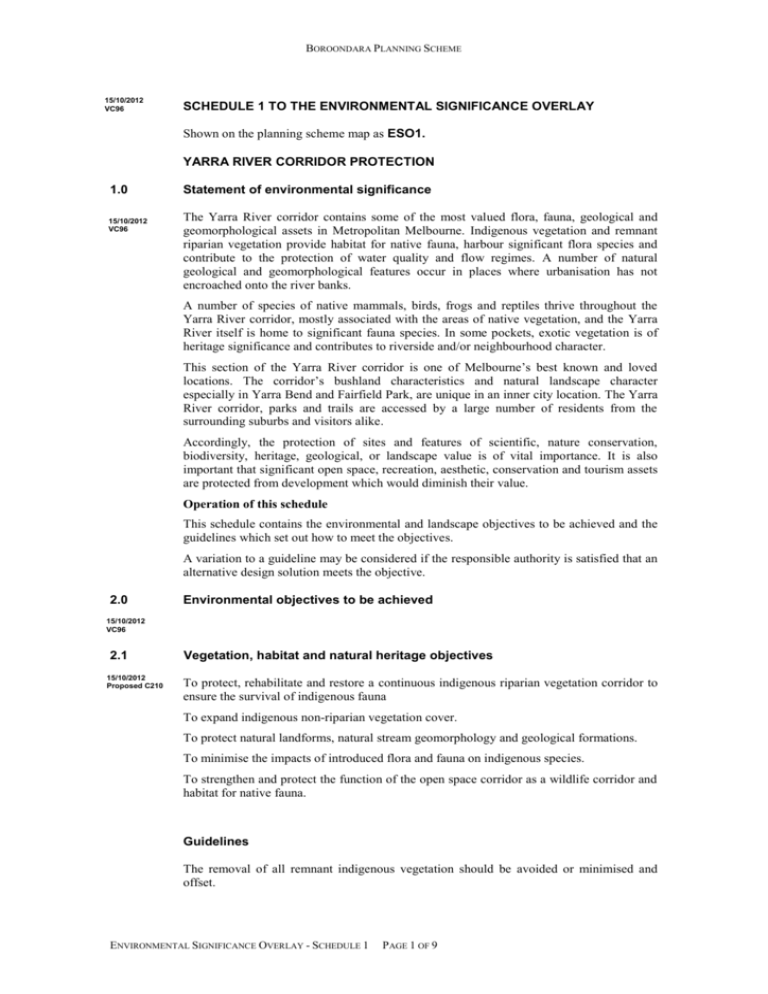
BOROONDARA PLANNING SCHEME 15/10/2012 VC96 SCHEDULE 1 TO THE ENVIRONMENTAL SIGNIFICANCE OVERLAY Shown on the planning scheme map as ESO1. YARRA RIVER CORRIDOR PROTECTION 1.0 15/10/2012 VC96 Statement of environmental significance The Yarra River corridor contains some of the most valued flora, fauna, geological and geomorphological assets in Metropolitan Melbourne. Indigenous vegetation and remnant riparian vegetation provide habitat for native fauna, harbour significant flora species and contribute to the protection of water quality and flow regimes. A number of natural geological and geomorphological features occur in places where urbanisation has not encroached onto the river banks. A number of species of native mammals, birds, frogs and reptiles thrive throughout the Yarra River corridor, mostly associated with the areas of native vegetation, and the Yarra River itself is home to significant fauna species. In some pockets, exotic vegetation is of heritage significance and contributes to riverside and/or neighbourhood character. This section of the Yarra River corridor is one of Melbourne’s best known and loved locations. The corridor’s bushland characteristics and natural landscape character especially in Yarra Bend and Fairfield Park, are unique in an inner city location. The Yarra River corridor, parks and trails are accessed by a large number of residents from the surrounding suburbs and visitors alike. Accordingly, the protection of sites and features of scientific, nature conservation, biodiversity, heritage, geological, or landscape value is of vital importance. It is also important that significant open space, recreation, aesthetic, conservation and tourism assets are protected from development which would diminish their value. Operation of this schedule This schedule contains the environmental and landscape objectives to be achieved and the guidelines which set out how to meet the objectives. A variation to a guideline may be considered if the responsible authority is satisfied that an alternative design solution meets the objective. 2.0 Environmental objectives to be achieved 15/10/2012 VC96 2.1 15/10/2012 Proposed C210 Vegetation, habitat and natural heritage objectives To protect, rehabilitate and restore a continuous indigenous riparian vegetation corridor to ensure the survival of indigenous fauna To expand indigenous non-riparian vegetation cover. To protect natural landforms, natural stream geomorphology and geological formations. To minimise the impacts of introduced flora and fauna on indigenous species. To strengthen and protect the function of the open space corridor as a wildlife corridor and habitat for native fauna. Guidelines The removal of all remnant indigenous vegetation should be avoided or minimised and offset. ENVIRONMENTAL SIGNIFICANCE OVERLAY - SCHEDULE 1 PAGE 1 OF 9 BOROONDARA PLANNING SCHEME Removal of non-remnant indigenous vegetation should be minimised. The Yarra River corridor, including riparian areas should be revegetated with locally appropriate indigenous vegetation (which may include trees and shrubs, reeds, sedges and other groundcover species) matched to the plant communities’ characteristic of the site and original landscape character. Retain exotic vegetation only where it has heritage or landscape significance and/or contributes to neighbourhood character . Development should protect natural river geomorphology and geological formations by avoiding major earthworks, minimising cut and fill of embankments and managing access. Mature, dead and dying native trees should be retained as habitat for native fauna, except where risk or safety hazard requires their removal. Development should not encroach into critical root zones of mature canopy trees to be retained. 2.2 15/10/2012 Proposed C210 Open space, recreation and access objectives To maintain and provide linear parkland along the Yarra River that connects with existing and proposed parkland areas. To maintain and enhance public access to and throughout the Yarra River corridor including access to the Yarra River itself and shared use of water access locations. To encourage the co-location or clustering of commercial or intensive recreational facilities to maintain secluded areas. Guidelines Subdivision and development should provide a public open space corridor along the Yarra River consistent with any open space plan, strategy or policy for the Yarra River referred to in this scheme. Open space areas or shared paths should not be used for vehicular access to development. Shared paths should have good visibility to help avoid conflicts and increase safety for users.. Developments should ensure that there is no loss of direct public access to riverside paths. Commercial development should only be allowed on public open space within the Yarra River corridor if it: Is accessible to a broad cross-section of the community. Does not detract from the primary recreational and scenic experiences intended for the site. Does not detract from the protection of natural systems and cultural heritage. 2.3 Drainage, flooding and waterway management objectives 15/10/2012 Proposed C210 To ensure development does not compromise bank stability or result in increased erosion. To ensure development results in no net increase in the rate or quantity of stormwater, sediment or other pollutants entering watercourses or wetlands. To manage the waterway public access and public works to ensure the protection and enhancement of river health and the Yarra River corridor landscapes. Guidelines Development should ensure fill batters are less than 1 in 5 for grassed slopes, 1 in 3 for vegetated slopes, or, if no alternative is available, are benched with benches no more than 1.2 metres high and at least 2 metres wide with a top setback of 3 metres. ENVIRONMENTAL SIGNIFICANCE OVERLAY - SCHEDULE 1 PAGE 2 OF 9 BOROONDARA PLANNING SCHEME 1 in 5 grassed slope for mowing. 1 in 3 slope for dense planting. Benched slope – to be used only when absolutely necessary. Impervious surfaces should be minimised in accordance with best practice urban stormwater management and water sensitive urban design and stormwater management requirements. Litter/Gross Pollutant traps should be installed at entry points to drains that serve large shopping centres, markets and other developments known to generate litter and sediment. 2.4 Urban and landscape character and built form objectives 15/10/2012 Proposed C210 To ensure subdivision, lot layout and building development provide a positive interface with the open space along the Yarra River corridor. To protect and enhance the landscape qualities of the Yarra River corridor as a vegetationdominated corridor. To protect the landscape character of the Yarra River corridor and to maintain and enhance the native vegetation and wildlife habitat values of the corridor. To ensure buildings and other structures on visible hill slopes and skylines are subordinate to vegetation and views are filtered through trees. To protect and enhance the skyline vista when viewed from the Yarra River, its banks, adjacent parks and trails, Yarra Boulevard and scenic viewpoints within the valley. Guidelines Signage The visual intrusion caused by advertising signs into the Yarra River corridor should be minimised. Fences Fences to the river’s edge should be avoided to allow for the free movement of wildlife and to minimise the visual intrusion of built structures into the landscape. Fences between private properties and the Yarra River corridor should be low or semitransparent to improve the visual interface and encourage passive surveillance. Building form, mass and siting Buildings should be oriented to front the open space along the Yarra River corridor, to improve the visual interface and encourage passive surveillance. The siting, spacing and design of buildings and works should be designed to avoid unreasonable visual impacts on the river corridor. The impact of building mass and siting on views of the Yarra River corridor, including from the opposite bank, should be minimal. Buildings should present visually interesting elevations on all faces visible from the public domain. ENVIRONMENTAL SIGNIFICANCE OVERLAY - SCHEDULE 1 PAGE 3 OF 9 BOROONDARA PLANNING SCHEME Buildings should be presented at a variety of heights to avoid a consistent wall of development along the Yarra River corridor interface. Building forms should be broken up to allow space for vegetation. Development should be designed and sited to prevent or minimise impacts that may degrade the cultural significance of a place. Buildings and works should be located to minimise overshadowing of all open space along the Yarra River corridor, Yarra River and recreational trails. Buildings and works should respectthe topography of the land. Site coverage Impervious surfaces should be minimised to allow for the filtration of water and the retention and establishment of indigenous riparian vegetation and canopy trees. Site coverage of developments should not exceed the guidelines in Table 1. ENVIRONMENTAL SIGNIFICANCE OVERLAY - SCHEDULE 1 PAGE 4 OF 9 BOROONDARA PLANNING SCHEME Table 1 Location Hawthorn South (Wallen Road to Monash Freeway) Kew (Wills Street to Caritas Christi Hospice) Site coverage guidelines The site area covered by buildings (including tennis courts and swimming pools) and impervious surfaces should not exceed 50% of the total area of land within the lot. Map of locations Hawthorn South Kew St James Park (Hawthorn Bridge to Wallen Road) Hawthorn The site area covered by buildings (including tennis courts and swimming pools) and impervious surfaces should not exceed 30% of the total area of land within the lot. St James Park The site area covered by buildings (including Hawthorn ENVIRONMENTAL SIGNIFICANCE OVERLAY - SCHEDULE 1 PAGE 5 OF 9 BOROONDARA PLANNING SCHEME Location (Barkers Road to Hawthorn Bridge) Garden Terrace, Kew (Walmer Street footbridge to Barkers Road) Site coverage guidelines Map of locations tennis courts and swimming pools) and impervious surfaces should not exceed 35% of the total area of land within the lot. Garden Terrace, Kew Building setback Buildings and structures should be set back from the river edge to allow for the establishment and retention of indigenous riparian vegetation and the free movement of wildlife. Building materials Buildings and structures visible from the corridor or the river should be sited, designed and finished to minimise visual intrusion into vegetation dominated vistas. This includes the use of dark, non-reflective colours on roofs and other external surfaces that blend with vegetation. Planted screening Canopy trees should be retained and additional canopy trees planted to protect and enhance the landscape character of the Yarra River corridor. Additional vegetation should be planted between the river and any buildings and in spaces between buildings. Driveways, garages and car parks and private recreation facilities Driveways should be designed and materials chosen to minimise visual impact and erosion. Car parks, swimming pools and tennis courts should allow space for screening and significant tree cover. ENVIRONMENTAL SIGNIFICANCE OVERLAY - SCHEDULE 1 PAGE 6 OF 9 BOROONDARA PLANNING SCHEME Car parking areas, where possible, should be incorporated within buildings, preferably underground where this can be achieved without impacting existing vegetation that contributes to the landscape character of the Yarra River corridor. Garage access to underground car parks should be visually concealed from the Yarra River corridor. The surfacing of open air car parking areas should be constructed of dark bitumen all weather asphalt with dark coloured matching concrete kerb and channel or bluestone kerb with a colour matching concrete channel. All car parking areas should incorporate a stormwater detention system to limit runoff. Boating infrastructure The location of boating infrastructure should be consistent with any Parks Victoria, Melbourne Water and/or Council plans, preferably near or among other existing commercial uses. Infrastructure includes: Mooring and landing facilities for river transport. Fishing facilities. Launch and retrieval facilities for small craft (rowing boats, canoes and kayaks). New boating infrastructure on public land should be designed and sited to: Cater for multiple users rather than single clubs or schools. Ensure safe launch and retrieval (e.g. in relation to river currents) and pedestrian safety. Avoid conflicts between boat users, vehicles, pedestrians and cyclists. Allow for service facilities where needed (e.g. pump-out, wash-down). Jetties, mooring facilities and bridges should be designed and sited to: Avoid the removal or destruction of indigenous vegetation. Protect river banks and aquatic ecosystems. Respect the natural landscape character of the immediate riverside environs. Minimise visual intrusion into the riverine landscape in views along and across the water. Locate parallel to the water’s edge and be constructed of durable heavy timber or concrete in natural weathered colours. Minimise the need for river dredging to maintain sufficient water depth. 3.0 Permit requirement 15/10/2012 Proposed C210 A permit is required for: A fence. A sign. Buildings and works associated with a bicycle, pedestrian or shared path. A permit is not required for: Playground equipment or sporting equipment, provided these facilities do not occupy more than 10 square metres of surface area on the site. Buildings and works identified on a management plan incorporated into this planning scheme. Works undertaken by a municipal council or public authority to: Sustain the form and stability of stream beds and banks, regulate or control the flow of water in the watercourse. Mitigate flooding, respond to flood emergencies or construct stream habitat works. Control or remove non-indigenous plants or carry out revegetation works, including preparatory works associated with the revegetation. ENVIRONMENTAL SIGNIFICANCE OVERLAY - SCHEDULE 1 PAGE 7 OF 9 BOROONDARA PLANNING SCHEME Maintain the landscape quality, horticultural health or bank stability of areas that have been restored or revegetated. Maintain or repair a bicycle path, shared pathway, or pedestrian path. Revegetation works including preparatory works associated with the revegetation undertaken by a ‘friends’ group provided written permission is obtained from the responsible authority. The requirement for a permit to remove, destroy or lop vegetation does not apply to: Any exotic tree with a single trunk circumference of less than 0.35 metre at 1 metre above the ground The pruning of vegetation to maintain or improve its health or appearance. A tree that has the capacity to adversely affect stream flow removed by a municipal council or public authority. The control or removal of non-indigenous plants in preparation for revegetation works by a municipal council or public authority. Application requirements An application must be accompanied by the following information, as appropriate: A detailed site description and design response report. A landscaping plan which shows: The location, area and percentage of existing and proposed hard / impermeable surfaces. The use of locally indigenous plant species (including trees, shrubs, reeds, sedges and other groundcover species). How natural landforms will be protected, including appropriate approaches to vegetation retention and planting, ground preparation and minimising ground disturbance. The protection and enhancement of vegetation. How erosion will be controlled and stability maintained or improved using ‘soft landscaping’ techniques. How the rate and quantity of stormwater leaving a property will be controlled and pollutants filtered, using ‘soft landscaping’ techniques. In addition, an application to remove, destroy or lop vegetation must be accompanied by the following information: An assessment of the significance of any native vegetation proposed for removal having regard to Victoria’s Native Vegetation: A Framework for Action 2002. An arborist report prepared by a suitably qualified arborist assessing the proposed vegetation removal. A description of the vegetation to be removed, including the extent and type of vegetation and the number and size of any vegetation to be removed. A written explanation justifying the removal of the vegetation. 4.0 15/10/2012 Proposed C210 Exemption from notice and review An application under this overlay for any of the following classes of development is exempt from the notice requirements of Section 52(1)(a), (b), and (d), the decision requirements of Section 64(1), (2) and (3) and the review rights of Section 82(1) of the Act: Construction of a fence. ENVIRONMENTAL SIGNIFICANCE OVERLAY - SCHEDULE 1 PAGE 8 OF 9 BOROONDARA PLANNING SCHEME 5.0 15/10/2012 VC96 Construction of a carport, garage, pergola, verandah, deck, shed or similar structure. Decision guidelines Before deciding on an application for a permit the responsible authority must consider as appropriate: The guidelines for each objective. Any relevant plan for the area set out in this planning scheme. The significance of the native vegetation area, including the significance of plant communities or animals species supported. The effect of the removal of vegetation on the landscape character, habitat value, wildlife corridor and long term viability of remnant and revegetated areas along the Yarra River corridor. The reasons for removing the vegetation and the practicality of alternative options which do not require the removal of the native vegetation. Whether the proposal complies with the objectives and policies included in Victoria’s Native Vegetation: A Framework for Action 2002. The effect of the height, bulk, spacing, setback and general appearance of any buildings and works on the environmental values and visual character of the Yarra River corridor. The extent to which buildings or works are designed to enhance or promote the environmental values of the Yarra River and the visual character of the Yarra River corridor. The need for landscaping or vegetation screening. The need to retain vegetation and natural features which contribute to the health and water quality of the Yarra River and the visual character of the Yarra River corridor. The need for water sensitive urban design and the opportunities for local retention and treatment of stormwater runoff. The effect on the natural beauty and on the future enjoyment of and access to the area by the community. Reference document Review of Policies and Controls for the Yarra River Corridor: Punt Road to Burke Road Consultant Report (Planisphere, June 2005). References Review of Policies and Controls for the Yarra River Corridor: Punt Road to Burke Road, (Consultant Report), Planisphere, June 2005. ENVIRONMENTAL SIGNIFICANCE OVERLAY - SCHEDULE 1 PAGE 9 OF 9
